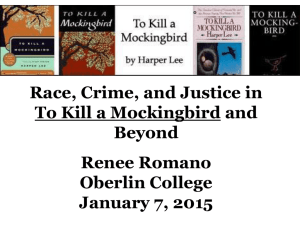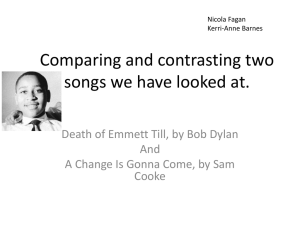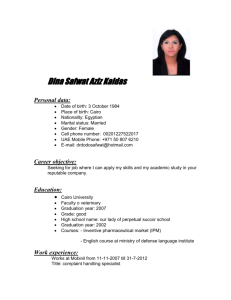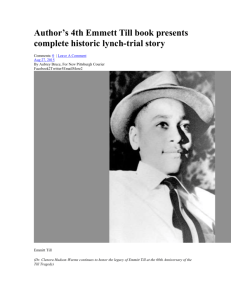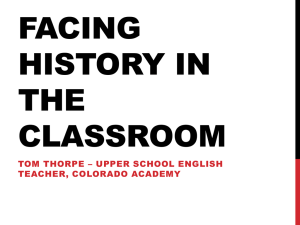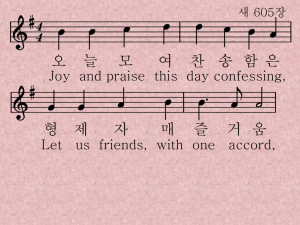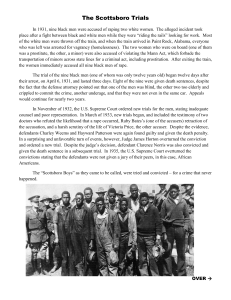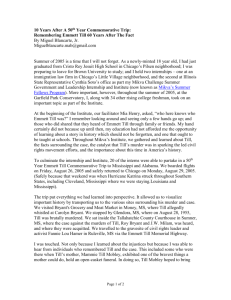Emmett Till Case Study Guide: History & Civil Rights
advertisement
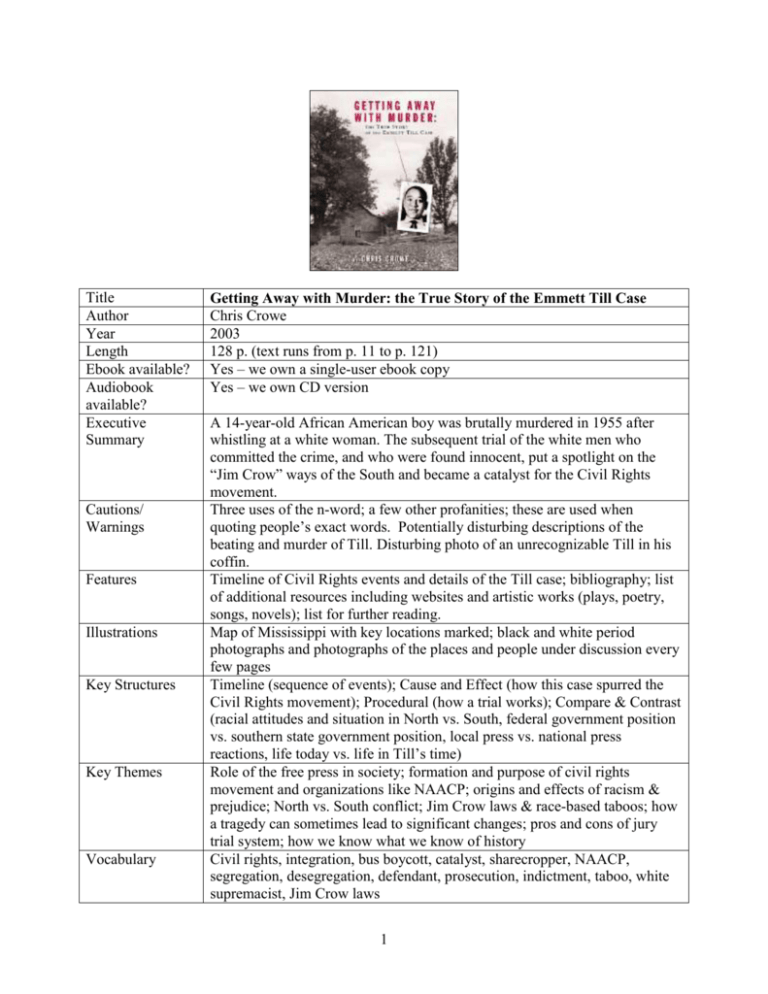
Title Author Year Length Ebook available? Audiobook available? Executive Summary Cautions/ Warnings Features Illustrations Key Structures Key Themes Vocabulary Getting Away with Murder: the True Story of the Emmett Till Case Chris Crowe 2003 128 p. (text runs from p. 11 to p. 121) Yes – we own a single-user ebook copy Yes – we own CD version A 14-year-old African American boy was brutally murdered in 1955 after whistling at a white woman. The subsequent trial of the white men who committed the crime, and who were found innocent, put a spotlight on the “Jim Crow” ways of the South and became a catalyst for the Civil Rights movement. Three uses of the n-word; a few other profanities; these are used when quoting people’s exact words. Potentially disturbing descriptions of the beating and murder of Till. Disturbing photo of an unrecognizable Till in his coffin. Timeline of Civil Rights events and details of the Till case; bibliography; list of additional resources including websites and artistic works (plays, poetry, songs, novels); list for further reading. Map of Mississippi with key locations marked; black and white period photographs and photographs of the places and people under discussion every few pages Timeline (sequence of events); Cause and Effect (how this case spurred the Civil Rights movement); Procedural (how a trial works); Compare & Contrast (racial attitudes and situation in North vs. South, federal government position vs. southern state government position, local press vs. national press reactions, life today vs. life in Till’s time) Role of the free press in society; formation and purpose of civil rights movement and organizations like NAACP; origins and effects of racism & prejudice; North vs. South conflict; Jim Crow laws & race-based taboos; how a tragedy can sometimes lead to significant changes; pros and cons of jury trial system; how we know what we know of history Civil rights, integration, bus boycott, catalyst, sharecropper, NAACP, segregation, desegregation, defendant, prosecution, indictment, taboo, white supremacist, Jim Crow laws 1 Introduction Summary: (pp. 11-14 – Author’s stated purpose for writing is to make sure all Americans know about 3 pages) the Emmett Till case, which he feels has not received enough attention in history education, and to demonstrate its impact on the development of the Civil Rights movement. Vocabulary: civil rights integration sham brazen Illustrations: map of Mississippi with some key locations marked Questions: Who was Emmett Till and what happened to him to make him the subject of this book? What events brought the Emmett Till case to the author’s attention? Why did the author write this book? Why does he think people should read it? Why is the murder of Emmett Till an important thing to know about, according to the author? What was the result of the trial of the accused murderers? What is the author’s opinion of the fairness of the trial and how can you tell? Why does the book start with a map of the state of Mississippi? Interesting Topics: Author’s purpose (making readers aware of the role this case played in the civil rights movement) Author’s bias (clearly sympathetic with the victim and calls the trial a sham) Cause & effect (outrage at the murder and the sham trial launched a movement to combat racism in America) Author’s craft (Q: why reveal the fact of the murder, the guilt of the accused, and the result of the trial in the introduction? A: because this is not an entertaining fictional murder mystery, this is a horrifying real-life tragedy; however, the mystery that has yet to be revealed is how the murderers were found innocent, and yet how we know for sure that they were guilty – this is the suspenseful part of the story.) Further Research: Brown v. Board of Education school integration ruling Montgomery bus boycott 2 Chapter 1 – Summary: The Boy An overview of the Till case and the aftermath. Starts with a dramatization of Who the night of the murder, compiled from witness testimony. Press and civil Triggered rights organizations react in outrage. The South is already facing criticism on the Civil its reluctance to integrate schools. Editorials in southern papers complain that Rights the whole South is being criticized for an isolated incident or that the media Movement coverage is a plot against the South. The week-long trial was witnessed by (pp. 15-26 – many and covered intensely by the press. The fact that the white attackers were 10 pages) even brought to trial was remarkable in a state where over 500 lynchings had taken place since 1880. Despite strong witness testimony against the killers, the all-white jury found the defendants not guilty. The verdict seemed to signal that Jim Crow and segregation were not going to go away. However, it spurred the Civil Rights movement forward in a way no other event had done before. Vocabulary: catalyst sympathetic whites sharecropper oblivious grisly lynching Illustrations: Scene of the kidnapping: the home of Mose Wright, Emmett Till’s great-uncle Crowd at Till’s funeral in Chicago Courtroom drawing of the trial – Mose Wright points to accused murderers Congressman Charles Diggs at the trial Questions: The author wasn’t around to witness any of the events first-hand. How do we know the events told on pp. 15-18 are true? By the end of the recreation of Till’s abduction on p. 18, what do we know about the following people: Emmett Till, Roy Bryant, J.W. Milam, Mose Wright? What unusual feature about Till’s funeral helped create a sense of outrage? How did the press help spread the sense of outrage from Chicago across the nation? What did the Supreme Court school integration rulings of 1954 and 1955 have to do with the racial situation in the South at the time of Till’s murder? How did white southerners react to national press coverage of the murder? What (if any) is the difference between a “lynching” and a “murder”? The word “spotlight” is used twice on p. 21 – how is it used and what is it referring to? What aspects of the trial were fascinating to the rest of the nation? Why was it a big deal that there was television coverage? What “time-honored customs” and “way of life” were being threatened in the South, and what was threatening it? 3 How did the “not guilty” verdict of the two clearly guilty murderers seem like a victory to both sides? How did the murder, the trial and/or the verdict launch the modern civil rights movement? What evidence of this does the author provide? By the end of chapter 1, we know a lot about the Till case. What key things do we not yet know? Interesting Topics: Author’s craft (why start the chapter with a recreation of the night Till was taken from his uncle’s home? Why start the book with what is essentially a summary of the rest of the book? What key details does the author exclude that leave a sense of mystery yet to be revealed?) Compare & Contrast (local media vs. national media; Northern vs. Southern attitudes; “sympathetic” whites vs. racist whites) Cause & Effect (how the murder, trial and verdict helped spur the civil rights movement) Further Research: NAACP Jim Crow laws 4 Chapter 2 – Summary: Kicking the Compares life for Northern Blacks with that of Southern Blacks. Emphasizes Hornet’s that Till, a young teenager from Chicago, enjoyed a quality of life that was Nest (pp. better than that in the south. Describes how the south reacted to the recent 27-36 – 9 Brown v. Board of Education school desegregation ruling. Steps inside and pages) outside the government took place to keep desegregation from happening in Mississippi and other southern states. Focuses on the speeches & writings of Judge Tom Brady, which predicted the destruction of the southern way of life if integration took place, called integration a Communist/ Socialist plot, and in warned about a hypothetical “young negro schoolboy … who has sojourned in Chicago” and who would inevitably make “a vile overture or assault upon some white girl.” This quote in particular seems to foreshadow what happened with Till. Brady’s writings and that of others stirred up fear and hatred. Two months before Till arrived in Mississippi, the Supreme Court mandated desegregation take place with “all deliberate speed.” This prompted protests and intensified efforts to keep Blacks from voting or running businesses, as well as violence against Blacks. Till stepped into a world that was very different from what he knew in Chicago. A quote from his mother demonstrates all that she feared he did not know: she told him how she thought he should behave around Southern whites, but “he didn’t know how to be humble to white people” and “thought that was the silliest thing he’d ever heard.” When two southern whites who shared Brady’s racist attitudes witnessed Till, a brash young Black teenager from Chicago, violating a southern taboo, it lead to his murder. Vocabulary: catalyst segregation desegregation integration taboo Illustrations: African American girl doing farm work in Mississippi African American mother and daughter on the Supreme Court steps holding newspaper with headline about the ban on school segregation White high school student holds sign reading “We won’t go to school with negroes.” White men watch black man painting “Waiting room for colored only” signs for use in Jackson, Mississippi Questions: Around the time of Till’s murder, what was life like for African Americans in Chicago? How did it compare to that in the South? What major, national events related to racial issues were taking place around the time of Till’s murder? How did Southern state governments, many white-owned businesses and many white citizens react to the Supreme Court ruling that made it illegal to have 5 segregated public schools? Who was Tom P. Brady? What is the author trying to prove by quoting Brady so much in this chapter? What quote is particularly appropriate as it pertains to what would later happen to Emmett Till? Who was Lamar Smith and why is he included in this book? What “basic liberties” were racist whites afraid would be “destroyed” by “rigid laws” such as the school desegregation ruling? There were plenty of official laws about segregation in the South, but there were also unwritten rules, customs, and taboos. What unwritten rules was Emmett Till’s mother concerned he would not follow? What do we know about Emmett Till after reading this chapter? What major facts about the case are still unknown to the reader at the end of the chapter, and how does the author use this lack of information at the end of the chapter? Interesting Topics: Compare & Contrast (North vs. South – racial attitudes; written laws vs. unwritten customs or taboos – how each would be communicated and dealt with should they be violated) Cause & Effect (how southern governments, press, and white citizens responded to the school desegregation ruling) Author’s craft (why so much time spent with Tom Brady in this chapter; how suspense is once again built at the end of the chapter) Further Research: Supreme Court school integration rulings – 1954 & 1955 White Citizens’ Council Ku Klux Klan Lamar Smith 6 Chapter 3 – Summary: The Boy Till’s brief life is set against the context of history. Till’s childhood in and near from Chicago was in a lower-middle class family. Chicago’s sizable and growing Chicago black population meant there were businesses employing blacks and catering (pp. 37-49 – to them in a way that was not happening in the south. Till had a sense of 12 pages) humor and an easygoing personality, and had a close relationship with his mother. He enjoyed earning money by doing chores for others. The Brown decision that had so rocked the south was hardly noticed by Till. In the spring of 1955, Till’s uncle Mose Wright came to visit from Mississippi and that’s when Till decided he wanted to spend the summer there. Wright insisted conditions in the south had never been better for blacks. Till’s mother worried that he would not “know how to treat white people” and warned him, “If you have to get on your knees and bow when a white person goes past, do it willingly.” Till and his cousin Curtis Jones left for Money, Miss. in August 1955. It was a tiny rural community, nothing like Chicago – the residents were poor, blacks worked for white sharecroppers, and blacks were routinely punished for violating Jim Crow laws. Till’s arrival brought excitement to the town – his southern cousins and their friends were spellbound by his “lack of fear of white people” and his talk of “white girlfriends, the forbidden fruit.” Till exaggerated these tales and furnished magazine photos of white women to prove that in the north, “black boys could have white girlfriends without any trouble.” He was treated like a celebrity and was having a great time, until August 24 when he crossed a boundary he never really understood. Vocabulary: Sharecropper Cotton gin Jim Crow Gullible Forbidden fruit Illustrations: General photo of downtown Chicago in 1953 Emmett Till’s mother, Mamie Till Bradley The first McDonald’s restaurant , 1955 Emmett Till in a hat and tie in 1954 Questions: Of the events that are listed on p. 37 that took place in America during Emmett Till’s 14 years of life, which ones do you recognize as having an influence today? Why don’t we hear much about Till’s father in this book? What was Emmett’s life like in Chicago? What was Chicago like at the time of Emmett’s life? Why does the author spend two long paragraphs discussing the White Sox? Describe Emmett’s personality in one sentence, and then find quotes from this chapter to support your statement. 7 How did the Supreme Court’s decisions on school desegregation affect Emmett’s life? Why did Emmett want to visit Mississippi in the summer of 1955? What about the Mississippi trip worried Emmett’s mother? What advice did Emmett’s mother give him about how to behave around white people in Mississippi? Describe the town of Money, Mississippi. Compare it with the parts of Chicago Till knew. Why was Emmett so fascinating to his Southern cousins and their friends? How did Emmett portray the relationship between blacks and whites in the North for his Southern audience? Why would a white girlfriend be considered “forbidden fruit”? Interesting Topics: Compare & Contrast (life in Chicago vs. rural Mississippi; life in 1955 vs. now) Author’s craft (How does the author make 1955 seem both a little alien and somewhat familiar to a modern audience? How does the author create suspense at the end of this chapter?) Further Research: The decade of the 1950s The Great Migration Baseball’s “color barrier” 8 Chapter 4 – Summary: The Wolf Till was dared to enter Bryant’s Grocery & Meat and ask Carolyn Bryant out Whistle (pp. on a date. Carolyn was a young married white mother of two. Till either forgot 50-69 – 19 or ignored his mother’s warnings and broke one of the south’s biggest taboos: pages) the mixing of races, particularly a black man and a white woman. Testimony from those inside the store, including Carolyn, states that Till grabbed her hand and asked her for a date, then tried to stop her when she fled to her apartment at the back of the store, saying she didn’t need to be afraid and that he’d “been with white women before.” Till’s friends came into the store and pulled him out; he said “Bye, baby,” as they did so. It is hard to know how much of that testimony is accurate. Carolyn exited the store to get a gun from her car and Till whistled at her (though others testified that he was whistling to clear his stutter, or in response to a question about how he liked her). The story got around quickly, and three days later Carolyn’s husband Roy Bryant returned home from a trip. He was furious at what he had heard. Carolyn begged him to forget about it. Blacks and whites alike assumed some kid of retaliation against Till would be forthcoming. Bryant and his half-brother J.W. Milam drove to Mose Wright’s house and hauled Till off at 2:30 in the morning. Till was beaten and killed, and his body was thrown in a river. Till’s relatives at Mose Wright’s home were frantic with worry. They’d been threatened to not call the police, but eventually they did. They also informed Till’s mother that he was missing. She asked Chicago police to put pressure on those in Mississippi, and she called every newspaper she could think of. Bryant and Milam were arrested for kidnapping. They insisted that they’d let him go alive. Till’s mutilated and bloated body was found in the river three days later. The kidnappers were charged with murder. A plan to quickly bury Till’s body there in Mississippi was changed at the last minute and the casket was shipped to Chicago. Till’s mother couldn’t recognize the body because it was in such bad shape and had to search it for clues to verify its identity. She requested an open-casket funeral so people could “see what they did to my boy.” The press ran photos of the disfigured body and accounts of the effects it had on those viewing it. Bryant and Milam were charged with murder. Vocabulary: Indicted Unprecedented Illustrations: Bryant’s store in Money, Mississippi Carolyn Bryant Mose Wright J.W. Milam and Roy Bryant Emmett Till’s mother overcome with grief Photo of Till’s corpse that was published in The Chicago Defender Questions: Why were Emmett Till and his cousins at Bryant’s Grocery & Meat Market on the evening of Wednesday, August 24th? 9 Who was Carolyn Bryant? Why was Emmett dared to go into the store and ask Carolyn Bryant on a date? Why was this such a “daring” thing to do? Who was the only witness to what happened inside the store, and what was her version of the events? What happened out on the street after Emmett left the store? According to the author, “everyone who had heard about the encounter between Emmett Till and Carolyn Bryant expected some sort of retaliation against Emmett.” What kept Carolyn’s husband Roy from retaliating until August 28th? Who helped Roy Bryant with the abduction of Emmett Till? How do we know what happened between the time Emmett was taken from Mose Wright’s home at gunpoint and his murder? Why didn’t Mose Wright call the sheriff after Emmett had been taken from his house? How did Emmett’s mother, back in Chicago, react to his kidnapping and disappearance? How did she put pressure on the sheriff way down in Mississippi? When they were arrested, what story did Roy Bryant and J.W. Milam give to the sheriff? What happened on August 31 that made the case something other than a kidnapping case? How was Emmett’s mangled body eventually identified? How did Till’s mother manage to get his body sent to Chicago? Why was it important to her and how did it end up being important to the case? How did the press cover the Emmett Till murder and funeral? Why was the indictment of Bryant and Milam considered so unusual? Interesting Topics: Author’s craft (combining different sources of evidence to create a more complete picture; pointing out parts of the story where only one possibly untrustworthy witness was available) Further Research: Find news articles from various sources from the time of the murder and the trial 10 Chapter 5 – Summary: Setting the Covers preparations for the trial and the first part of the trial up through jury Stage (pp. selection. Public pressure from the NAACP and Till’s mother through the 70-83 – 13 national media resulted in local authorities and southern citizens becoming pages) defensive of their way of life and resentful of outside pressure, even though most white residents loathed siding with two unpopular “rednecks” who had “overstepped their white authority”. The local sheriff told press that the body wasn’t Till’s and that Till was probably still alive. Defense lawyers’ strategy was to find a legal way for the white jurors to declare the killers innocent, and to present the accused killers as “patriots” with good reputations. Prosecution was handled by the state’s District Attorney General and with a reputedly fair judge. Courtroom had typical Jim Crow restrictions on where blacks could sit and how many could be in the room. As jury selection began, the prosecution opted to not seek the death penalty, with the hopes that would help with jury selection. The pool of jurors contained only whites because only registered voters could be jurors and there were no registered black voters in the county. Defense relied on the sheriff’s personal knowledge of the potential jurors during selection. Prosecution looked for jurors who were not personal friends of the defendants. Defense was able to get an additional day to round three additional witnesses, and the evidence and testimony portion of the case could proceed. Vocabulary: Evidence Testimony Witness Jury Prosecution Defense Illustrations: Milam and Bryant at the trial The Tallahatchie County courthouse Milam and Bryant with their young sons at the trial Attorneys at the trial Sheriff Strider addressing the jury at the trial Questions: Describe how the following groups or individuals reacted to the murder charges: the NAACP; Mamie Till Bradley; the White Citizens’ Council; Mississippi Governor Hugh White. How did the opinion of local authorities toward prosecuting Bryant and Milam change, and why? Name and describe the major people involved on the side of the prosecution. Name and describe the major people involved on the side of the defense. Why was the defense’s “victory assured even before the trial began”? How did the defense use pre-trial publicity to ensure this “victory”? 11 What factors made the trial as fair as it could be? Describe what it was like in the courthouse on the first day of the trial. Why did the prosecution choose to not seek the death penalty? Why were there no black men on the jury? How did the defense select jurors who would “play along” with them? What questions did the prosecution ask in order to screen jurors? What kind of press coverage was allowed during the trial? When the prosecution was given an extra day to round up witnesses, why were they never able to find Leroy Collins and Henry Lee Loggins? Who did they round up instead? Interesting Topics: Procedural (how is a jury selected; what is the difference between testimony and evidence) Further Research: Jury trial 12 Chapter 6 – Summary: Getting Description of the trial and its outcome. Judge Swango, while allowing some Away with illogical and legally inconsistent things to happen, conducted the trial in a way Murder that earned him respect from both sides. State called Mose Wright, who (pp. 84-106 identified the two killers, and maintained his testimony during cross– 22 pages) examination. State called the sheriff, who said that Bryant told him he’d picked up Till but let him go since “he wasn’t the right one.” State called two undertakers who described the condition of the body found. Till’s mother was questioned about her ability to identify the body. Eyewitness Willie Reed testified that he’d seen men take Till into a barn on Milam’s brother’s farm and heard screaming. Defense got him to admit he had not seen Milam and that he didn’t know how far away he was from the truck. Two more eyewitnesses were questioned, as well as two other sheriffs who reported that Bryant and Milam had confessed to the abduction. Defense had Carolyn Bryant testify about her encounter with Till at the store, but this was told without the jury being present. Defense called another sheriff who testified that the body had likely been in the river for 10-20 days and was impossible to identify. More experts backed up that angle. Five character witnesses testified on behalf of the accused killers. Prosecution closed by reminding jurors that this was a case of murder of a child by two grown men. The defense stated that putting a corpse in a river was a possible plot of those who wanted to destroy the south’s way of life and that “every last Anglo-Saxon one of you men in this jury” should set the accused free. The identification of the body and the identification of the killers were both questioned. An hour later, the jury found the accused not guilty. Vocabulary: Deliberation Reasonable doubt Credibility Cross-examination Illustrations: White spectators at the trial Mose Wright pointing at the trial Emmett Till’s ring, found on the body Witness Willie Reed and prosecuting attorney Gerald Chatham Building where the beating occurred Deputy with the heavy fan used to weigh down Emmett’s body in the river Milam and Bryant with their attorney Milam, Bryant and their wives celebrating after the “not guilty” verdict Questions: The title of this chapter is “Getting Away with Murder.” It’s also the title of the book. What does that tell you about this chapter? What information did Mose Wright’s testimony provide? What do we learn about Mose Wright’s character in this chapter? 13 What was Sheriff Smith’s version of the events? What information did Mamie Till Bradley’s testimony provide? What do we learn about Mamie Till Bradley’s character in this chapter? What information did Willie Reed’s testimony provide? How did the defense attack this testimony and discredit it? How did the testimony of Carolyn Bryant help sway the white audience? Why did the testimony have no effect on the jury? What was the main strategy of the defense? The defense of the killers was based mostly on the assertion that the body found could not be identified as Till’s. How did the technology at the time limit the ability of law enforcement to prove such things? What was the point of the testimony of the character witnesses for the defense? During closing arguments, what was John Whitten’s theory about why all of this happened? What threat did Sheriff Strider make after the trial? How does this threat contradict the entire defense strategy? What was the point of including the Greenwood Commonwealth article at the end of this chapter? Who were the plantation workers mentioned in the last sentence of the article? Interesting Topics: Procedural (procedures of a trial – prosecution, defense, cross-examination, dismissing the jury for part of the testimony, closing arguments, deliberation) 14 Chapter 7 – Summary: Aftershocks The outcome of the Till case sparked intense and sympathetic reactions by the (pp. 107NAACP and national media, putting a spotlight on something that had been 121 – 14 somewhat hidden from the nation. Many young blacks felt fearful for their pages) lives and this inspired them to stand up to racism. Politicians, the NAACP, civil rights workers, church leaders, and ordinary people were joined together by the catalyst of Till’s murder and the unfair outcome of the trial. Rosa Parks was one such person and her bus boycott began just a few months later. The killers, having been found innocent, were free to sell their story to a magazine and confessed to the kidnapping, beating and murder of Till in front of the whole nation. Though they couldn’t be tried for the same crime again, they were ostracized from their community. The interview was another civil rights catalyst. While the killers died in obscurity and shame, Till’s mother became a teacher and continued to speak on behalf of civil rights. The lesson she so painfully learned is one she hopes everyone learns: that “what happens to any of us, anywhere in the world, had better be the business of us all.” Vocabulary: Catalyst Indignity Galvanize Symbol Illustrations: Medgar Evers of the NAACP Emmett’s mother surrounded by reporters at the trial Rosa Parks riding on a city bus in Montgomery after the bus boycott Milam and Bryant outside the courthouse Witnesses from the trial, including Mose Wright and Willie Reed Emmett’s mother in 1995, 40 years after his murder Questions: How did the press react to the verdict? How did civil rights groups like the NAACP react? How did the trial’s outcome affect many African Americans? Who were Anne Moody, Joyce Ladner, and Rosa Parks, and how did the Emmett Till case end up being important to them? The photograph of Emmett in the coffin is described as a “symbol” – what did it symbolize, according to Ladner? Re-write this sentence in your own words: “The trial of Emmett’s killers was the necessary and final catalyst for a united effort against racial discrimination in America.” Why were Bryant and Milam sent back to jail briefly after the trial? After being found not guilty, three months later the killers admitted they committed the crime in a magazine interview that was published for the entire nation to read. What was their motivation for doing the interview? Why were they not arrested and put in jail after confessing to the murder? Is all of the 15 information in their interview necessarily accurate? How did the killers make it seem like Emmett was to blame for his own murder? What did Milam mean when he called Emmett “hopeless”? How were the killers treated in their community after the magazine interview? What was their ultimate fate? What reactions did the confessional article cause among African Americans and everyone interested in civil rights? What happened to the black witnesses after the trial? What was the “painful” and “long-lasting” lesson learned by Emmett’s mother, according to the author? Interesting Topics: Procedural (why were Bryant and Milam allowed to stay free after confessing to murder – because they had already been found innocent and could not be tried twice for the same crime) Cause and Effect (how the murder, the apparently unjust outcome of the trial, and then the definite knowledge of the injustice of the trial after the interview, all helped galvanize the civil rights movement into action) Further Research: Rosa Parks Medgar Evers Mamie Till Bradley General Questions: How would the murder and/or trial have been different if it had taken place today, purely in terms of the technology available? Think about forensic science and about communication technology (internet, cell phones, cameras, etc.). How does this case compare with a recent case with similar aspects (Treyvon Martin’s death)? Describe some other historical events where a significant tragedy eventually led to a positive change. What factors, customs, situations, laws, etc. ultimately allowed Bryant and Milam to “get away with murder”? Which of these have changed significantly since that time? Further Reading Fiction: Mississippi Trial, 1955 by Chris Crowe. The same author who wrote Getting Away with Murder presents the story in a historical fiction young adult novel. A Wreath for Emmett Till by Marilyn Nelson. An illustrated poetry collection celebrating Emmett’s life and mourning his death. Non-Fiction: 16 Death of Innocence: The Story of the Hate Crime that Changed America by Mamie Till (Bradley) Mobley. Completed in 2003 just before her death, Emmett Till’s mother tells the story of Emmett’s murder and the trial, and how she used this loss to help inspire the civil rights movement. 17
